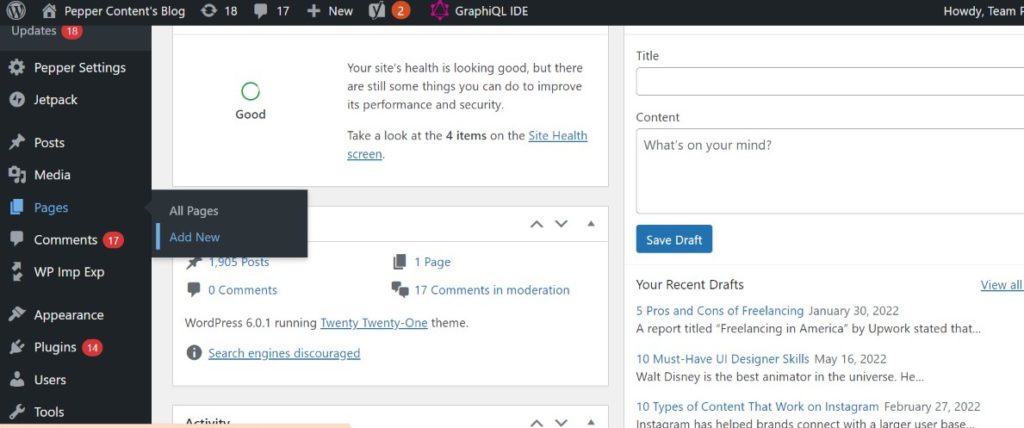
Are you a foodie who loves trying out new food? Do you love cooking or baking? Would you like to share your interesting food recipes and ideas with others? If yes, then it’s time to start a food blog and show off your amazing food blog ideas to the world.
Food blogging has become a very popular niche, with more and more food lovers starting food blogs. Whether it’s Instagram or YouTube, you can find a lot of interesting food-related content that is gaining popularity online. Food blogs are one of the best niches to dive into because you have plenty of different topics to write about.
With a food blog, you could share interesting content like instructional blogs, recipe reviews, how-to articles, demos, different food techniques and ideas, etc. There are plenty of different ideas that you could use to make a successful food blog.
In this guide, you’ll learn how to start a successful food blog in five simple steps and also how you can make money through your food blog.
What Is Food Blogging?

To begin, let’s first define what food blogging is.
Though this may seem like a simple question, there isn’t a concrete definition. A blog is a journal created online to share your thoughts about a certain subject or niche. It’s a website that’s created to showcase information and knowledge about a particular topic.

A food blog is created to share content like recipes, food ideas, food techniques, and other food-related information. Once you open a food blog, you can earn money by selling your branded products, promotions, and affiliated marketing programs.
How to Start a Successful Food Blog in 5 Simple Steps
Here are five simple steps to start a successful food blog.

Step 1: Choose a food blog name and niche
Before you dive right into starting a blog, you first need to find out exactly what you want to blog about. If you want to build a food blog that’s successful and profitable, then you need to do your research.
Sit down and write at least 20 food blog post ideas that come to your mind in 10 minutes. Here is a list of different types of food blogs that you could look at:
· Recipe blogs
· Tasting blogs
· Cookbook review blogs
· Cuisine-specific blogs
· Healthy eating blogs
· Travel and food blogs
· Location-specific food blogs
· Sustainable cuisine
You could choose from the above list as a starting point and then go ahead and drill down and come up with your blog ideas that will engage the audience.
Once you’ve got the main topic, you need to come up with a name for your food blog. Think about the topics, the target audience, and blog style. Once you’ve chosen the name and topic, you need to set up your food blog.
Step 2: Set up your food blog
Starting a food blog can be stressful, especially if you do not have a technical background. However, don’t worry; this guide will show you how to set up your food blog in the best way possible.
When starting a food blog, you need to keep in mind the following three elements:
A unique domain name: The unique domain name is what is typed in the web browser to search a blog. It is usually the same as the name of the blog. You must ensure that the domain name is easy to type and say.
A reliable web host: All the content, files, and images are stored here. So, a reliable web host is a part of setting up a blog.
A blogging platform: This will be the software you will use to write and publish your food blogs. Here, you can add layouts, designs, and different elements to your site.
You can use WordPress, a popular blogging platform. WordPress powers many big names like Rolling Stone, Adobe, and Microsoft. It’s an easy-to-use platform and flexible. It offers a wide variety of features perfect for starting a food blog. Some of the most popular food blogs are using the WordPress platform for blogging.
When choosing the right blogging platform, many new bloggers are confused and get stuck because they do not want to pay for hosting right at the start. So, they usually choose free blogging options. However, if you’re looking to retain ownership and control of your food blog, it’s always advisable to go in for paid hosting options.
Step 3: Create your content and begin blogging

Now you’re all set to begin creating your food content and publishing it. If you’re using WordPress, then it allows you to create two types of content – pages and posts. When starting your food blog, it’s recommended to create the following pages for your food blog.
About page
On the About Page, you must introduce yourself and talk about what the readers can expect from the food blog. If you have other social media platforms, then link those profiles so the readers can get in touch with you.
Contact page
For your readers to get in touch with you, it is necessary to create a contact page. You can create a contact form without hassle using WPForms. This is pre-installed on the Bluehost site.
Once your pages are created, you can add them to your new blog main menu.
Step 4: Promote your food blog
Now it’s time to promote your food blog. There are many different ways to promote your new food blog. Some of them include:
Search engines
With the help of search engine optimization (SEO), you can use search engines’ help to drive traffic to the new food blog. So, when people search for a particular topic on Google that you have covered, your food blog will show up in the search.
Social media
Facebook, Instagram, Twitter, and Pinterest are big platforms for food bloggers, especially if you’ve got some eye-catching photos and content that will grab attention. Social media platforms like this can help grow your audience and also help to monetize your blog as well. The first thing you need to do is to look out for some of the most popular food blogs in your niche.
Check what platforms they are using and what type of content they are posting to get an idea of how things work. Remember likes and followers can be easily faked; the idea is to see how engaging their content is and how much of their food content is shared. Also, check for interactions as well.

Once you’ve figured out how things work for them, you can start testing the same techniques and strategies on your new food blog.
Choose one or two platforms and start creating content. Share the content on the chosen platforms and engage with the audience. You can also ask people to follow your accounts on those social media platforms. Social feeds can help increase engagement, boost followers, and easily provide readers with fresh content.
Email newsletter

Some of the most popular food bloggers use email newsletters to connect with their audience and stay engaged. Email newsletters are a great way to build relationships with the audience. It is a powerful marketing strategy that you must have to promote your food blog.
Step 5: Monetize your food blog

There are many different ways to monetize your new food blog. Here are a few ideas that you can use:
Sell recipes
This is a strategy used by some of the best food blogs. You can have all your unique and interesting food recipes put into an eBook format, and directly sell them on your website. However, you will require an eCommerce plugin to go ahead and add your online store to the new food blog.
Sell your branded products
Once you’ve built a substantial audience, you can start selling your branded products on the website. You can sell different merchandise like cookware, mugs, etc., that your followers can use and also in turn promote your blog.
Display ads
Setting up Google AdSense is another great way to monetize your food blog. With Google AdSense, you can display ads on your food website and earn whenever the ad is clicked.
Affiliate marketing
How-to videos and product reviews are a popular way of earning money on a food blog. When you write product reviews, you can easily put in a few affiliate links to earn a commission off products you review or write about.
You can begin with Amazon’s affiliate marketing program and slowly move into different food-related affiliate programs once your audience grows.
Start a YouTube channel and monetize it
YouTube is the second largest search engine platform after Google. Hence, you must also consider creating a YouTube channel. This is important because many people use YouTube to learn new food recipes or food tips and tricks. So, having a YouTube channel will help to attract more people and also earn money as well.
Offer consulting
Once you’re successful, you can always start offering your audience consulting services. Most people are always looking for help when it comes to cooking, so you can consider offering coaching sessions or other consulting offerings that may be helpful.
Things to Consider Before Starting a Food Blog
You must consider a few things before starting a successful food blog.
1. Do you enjoy cooking?
This is the first thing you must look at before starting your food blog. If you don’t enjoy cooking or trying new recipes, it would be really difficult to start a food blog that engages the audience.
To start a food blog, you must have a passion and love for cooking for your blog to be successful. You must be willing to spend more time in the kitchen trying out new recipes.
Another thing to keep in mind is to narrow down the target audience so that it becomes easier to create content targeting a specific type of audience. Creating content that does not suit your main audience would waste time, money, and energy.
2. You need a lot of time for promotion
Promotion is key when starting a food blog. No one will notice your blog if you do not promote it well.
You must use social media blog promotion. Networking with popular food bloggers is another way of building your audience. You must like, share, and comment on other blogs to gain attention. Also, replying to comments is important when promoting your blog.
Remember, this takes up a lot of time and energy, so make sure to set aside a minimum of two hours each day to promote your food blog. Without time, patience, and dedication, it will be impossible to grow your food blog.
3. You require an email list
Are you aware that an email list is a powerful tool when creating a food blog? You must try and collect emails from the day you begin because it will help you in a big way. Here are a few things you could do to grow your email list:
● Offer discounts or freebies
● Engage with email subscribers regularly
● Use popups
● Treat all your email subscribers just like family
Advantages of Becoming a Food Blogger
There are many advantages of becoming a food blogger. You can choose to become a food blogger in a particular niche to engage with your audience and earn as well. Some of the advantages of becoming a food blogger are as follows.
1. You’re your boss
Being a food blogger allows you to be your boss. You get to run the show and take care of its content, design, and everything else attached to your blog. You have the creative freedom to do whatever you like to make your blog successful. Once you grow and expand, you can then hire a team to help you function better.
2. You can monetize the blog
Another advantage is that you can turn your food blog into a career and earn from it. Many food bloggers in India and worldwide smartly use food blog ideas to monetize their blogs.
Once you’ve gained a good following, you can use your food blog for advertising and promoting products to earn money. With a food blog, you can create recipes for various brands and content for them.
3. Learning new things every day
When you become a successful food blogger, you get to work on different recipes and ingredients every day, so you’re continuously learning new things that you can use to create unique recipes for content on your food blog.
4. Make real connections
Food blogging allows you to be in touch with many different people who are your readers. It also introduces you to other communities, allowing you to build strong connections that will help you in the long run. Through blogging, you get to make close friends who are in the same profession and love food just like you do.
5. You get to travel
Another great advantage is that your work also allows you to travel. Once your blog grows and you become popular, you may be invited to events and workshops. You’ll also get invited for various media trips too.
Key Takeaways
● Food blogging is an interesting career choice to make. However, you must have a love and passion for cooking to make your food blog successful.
● You need web hosting and a registered domain to start a food blog. You can then select the right theme and then start blogging.
● There are different types of food blog niches to choose from. Some of them are – recipe blogs, tasting blogs, cookbook reviews, cuisine-specific blogs, healthy eating blogs, travel and food blogs, and location-specific food blog.
● When starting a food blog, you need to remember the following three elements – a unique domain name, a reliable web host, and a blogging platform.
● If you’re using WordPress, it allows you to create two types of content – pages and posts.
● Promote your blog through social media, search engines, and email marketing.
● Monetize your food blog by selling recipes and branded products, display ads, affiliate marketing programs, starting a YouTube channel, and offering consultations.
Conclusion
Creating a food blog may seem easy, but making it successful depends on you. Being a successful food blogger takes time; you have to stay consistent and keep posting engaging and valuable content that your audience love.
With time, your blog will grow and gain popularity soon. Proper keyword research, the right hosting, and monetizing strategy are the three important elements to help make a successful food blog.
FAQs
Starting a food blog isn’t difficult, especially if you have a passion for cooking. All you require is web hosting and a registered domain. You can select the right theme for your blog and start blogging.
There are many different ways food bloggers earn money through blogging. Google AdSense, affiliate marketing, sponsored posts, YouTube vlogging, consultation, etc., are some of the ways you could use to monetize your blog.
You can begin with creating a micro food blog by choosing a niche. Start with an attention-grabbing Instagram profile by consistently posting engaging content and eye-catching food photos.
You can start a food blog for free by using some free platforms like WordPress, Blogger, and Tumblr.
First, you must focus on making a good follower base. Once you’ve reached around 5000 followers, you can start collaborating with brands in your niche. Also, you can promote your products and affiliate products to make money.
Latest Blogs
Learn how to rank on AI search engines like ChatGPT, Perplexity, and Gemini by optimizing your content for authority, structure, and relevance. Stay ahead in AI-driven search with this strategic guide.
Explore the best healthcare SEO services for your medical practice. Improve online visibility and effectively reach more patients in need of your services.
Discover top social media agencies specializing in banking solutions, enhancing financial services and driving engagement.
Get your hands on the latest news!
Similar Posts

Artificial Intelligence
5 mins read
Top AI Blog Writing Tools for Website Monetization

Blogging
4 mins read
10 Best Translation Blogs To Follow In 2022

Blogging
11 mins read